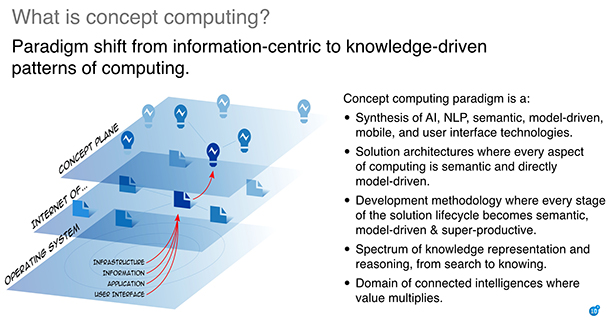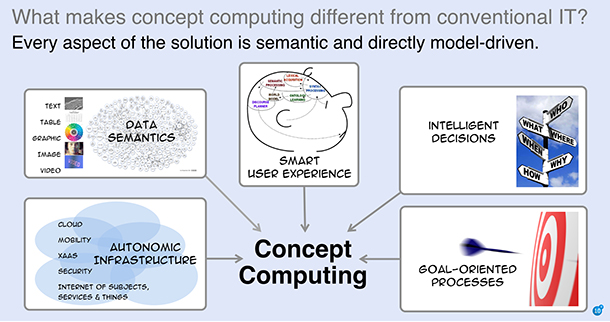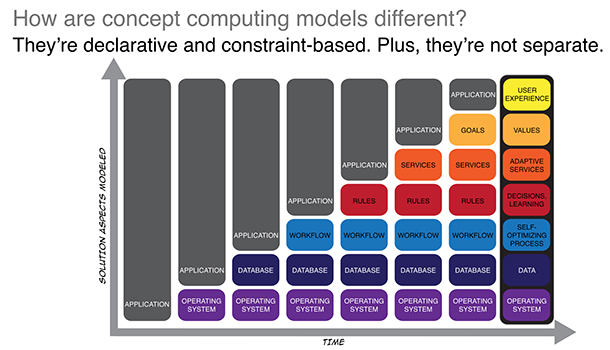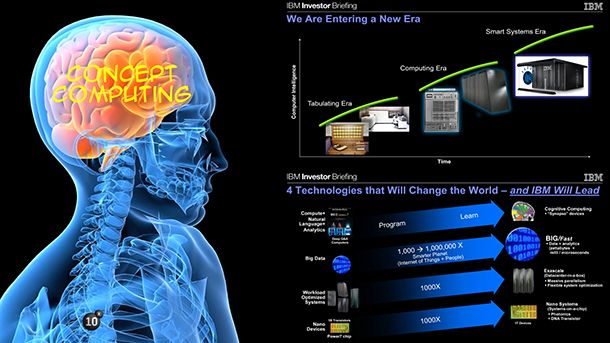Concept computing represents and processes knowledge about domains, user interface, application functionality, processes, information, and infrastructure separately from the underlying IT systems and other artifacts so that both people and computers can interpret concepts and put this knowledge to work.
Concept computing is a new paradigm.
It uses semantic models to drive every aspect of the computing solution. This diagram highlights five aspects:
- Smart user experience
- Data semantics
- Intelligent decisions
- Goal-oriented processes
- Autonomic infrastructure
Also, these direct-execution models power every stage of the solution life cycle end-to-end—from initial development to operations, to ongoing changes and evolution of new capabilities.
Concept computing provides a unified environment for creating, managing, and executing all types of knowledge.
Different kinds of models are connected, not separate. Models are declarative and constraint based. Not procedural.
Historically, lots of things have been modeled separately. But, modeling only seemed cost-effective for individual aspects of software applications.
Going back to the beginning of IT, there was only an application program. It was a deck of cards that gave instructions to a computer. It was low-level code.
Over the decades, we began model knowledge about some things separately and take this functionality out of the application, so that multiple programs could share it. The sequence was something like this: operating systems, then data, workflow, rules, services, and goals.
As modeling evolved, different kinds of concepts required separate tools to model them. With different kinds of modeling tools came different formalisms and standards.
For example for: data schemas, decisions using business rules, processes flow-charted with BPMN, services accessed through APIs. Different formalisms and standards result in tools that don’t know about each other and don’t share semantics.
That’s a problem when you want to combine multiple types of models in an application. It gets complicated. Often you are obliged to write some code. Other times, you import or export models into other tools, which adds a layer of complexity.
With concept computing this extra work goes away. Different types of models all execute in the same environment. Solutions self-document. Systems can always explain their decisions and actions. Behavioral compliance with policies, standards, and regulations can be shown.
Concept computing demands big think.
What is different is that memory and compute power is becoming a non-issue. Super computing will be everywhere. Supercomputing at the edge. In smart devices. In the cloud. Intel, Nvidia, Cray, IBM, and more. Semiconductor companies have supercomputing roadmaps and market plans.
Speaking of technology drivers for concept computing. Look at the two diagrams from IBM to the right. The first says we started with tabulating machines and we are now entering the era of smart systems. The second diagram identifies four technologies that will have a 1000X impact on capability and performance. The top one is cognitive computing.
Understanding concept computing
The following presentation overviewing concept computing was given at AAAI 2012 in Toronto, Canada.




